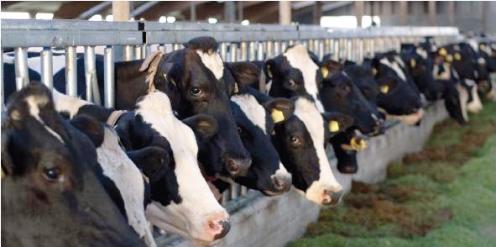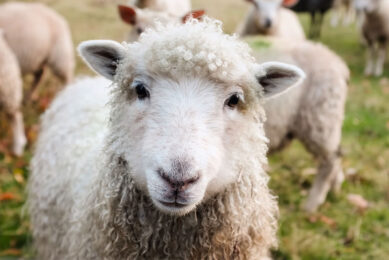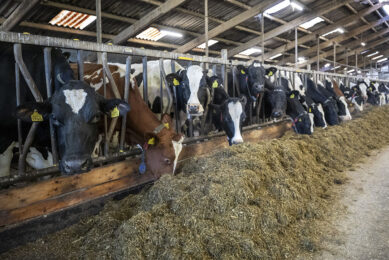Feeding measures to lower methane emissions

Livestock related emissions will increase as world population and food demand increases; enteric CH4 emissions are projected to grow by over 30% from 2000 to 2020. There are mitigations available now, but it is imperative to develop new improvements and ways to implement existing technologies more cost effectively.
| Efficient animals require less feed than average and can be expected to produce less CH4 and N2O. |
Animal agriculture is responsible for 8–10.8% of global greenhouse gas (GHG) emissions as assessed by IPCC accounting and, on the basis of lifecycle analysis; the contribution of livestock is up to 18% of global emissions. Asia is the source of the most enteric CH4 emissions with Latin America, Africa, Western Europe and North America being significant sources. These emissions are dominated by emissions from cattle. When greenhouse gas emissions are related to food production, the four most efficient regions are Eastern and Western Europe, North America, and the non-EU former Soviet Union which produced 46.3% of ruminant meat and milk energy and only 25.5% of enteric CH4 emissions in 2005. In comparison, the three least efficient producers (Asia, Africa, Latin America) produced an equivalent amount (47.1%) of ruminant meat and milk energy, and almost 69% of enteric CH4emissions in 2005.
Farm based studies indicate that there are large differences among farms in animal productivity and environmental performance. A report was made on regional variations in dairy, beef, pork, poultry and egg production, and related GHG emissions in the 27 Member States of the European Union (EU-27), based on 2003–2005 data. The dairy sector had the highest GHG emission in the EU-27, closely followed by the beef sector. Enteric fermentation was the main source of GHG emissions in the European livestock sector (36%) followed by N2O soil emissions (28%). On a per kg product basis, beef had by far the highest GHG emission (22.6 kg CO2-eq/kg). The figure for pork was 3.5 kg, for milk 1.3 kg, for poultry 1.6 kg, and for eggs 1.7 kg.
An International Farm Comparison Network (IFCN) study quantified and compared greenhouse gas emissions of bovine milk production systems in 38 countries representing 70% of the world’s bovine milk production. Results show that GHG emissions at the farm level are lower in developed than in developing countries. Differences were mainly due to the level of intensity (i.e., milk yield/cow) in milk production. Enteric CH4emissions comprised the highest proportion of GHG emissions. Enteric and manure related emissions accounted for 70–95% of total emissions of farms depending on the farming system.
Efficient animals
Efficient animals require less feed than average and can be expected to produce less CH4 and N2O per unit product than the population average at a similar level of production. Selection for this trait will lower CH4 emissions per animal, unless more animals are kept to eat the feed not required by efficient animals.
It is of great importance to select high producing animals, as this will reduce emissions/unit of product, referred to as emissions intensity. Efficient animals are likely to increase farm profitability. Efficient animals are already in all herds and flocks and research must identify and remove inefficient individuals, while retaining and ensuring efficient ones. However, the biggest benefits of reducing emissions and increasing production will be associated with good animal management practice (e.g., appropriate genetics, reproductive performance, and longevity) with efficient animals superimposed. One dilemma for agriculturists will be the practice of feeding grains to ruminants, as gains in animal efficiency, especially in reduction of emissions intensity, are likely to be biggest with high energy density rations, but feeding grain to ruminants may become an unsustainable practice if food supplies for humans are limited.
Ruminant dietary experiments
The rumen microbial ecosystem is very complex and involves thousands of species of bacteria, archaea (single cell organisms), protozoa, fungi, and viruses, which interact with the feed, their host and each other. This ecosystem is relatively poorly understood, particularly inter-species interactions and interactions with the host. Less than 15% of the microbial species in the gastrointestinal tract have been cultured and characterised. However, knowledge of this ecosystem is accumulating, particularly with the advent of molecular biology and culture independent technologies.
There are limited data in the literature concerning in vivo effects of dietary fat supplementation on enteric CH4 emissions from lactating dairy cows. An Australian experiment evaluated four dietary treatments designated as a control, brewers grains, hominy meal and cold-pressed canola and hominy meal only for their effects on CH4 emissions and milk production. Fat supplementation did not influence DM intake and there were only small positive effects on milk yield and negative effects on concentrations of milk fat and milk protein. Compared to the control diet, fat supplementation reduced CH4 emissions for at least seven weeks. Combining the results of this investigation with data from the literature, it was concluded that for each increase of 10 g/kg DM in dietary fat concentration, enteric emissions are reduced by 0.79 g CH4/kg DM intake or 3.5%.A Norwegian study assessed the impacts of increasing dietary levels of glycerol on in vitro ruminal fermentation and CH4 production from a barley based feedlot diet. Glycerol is rapidly fermented to propionate in the rumen. Due to the inverse relationship between propionate production and enteric CH4 emissions, glycerol may reduce rumen CH4 production. Glycerol was used as a replacement for barley grain at different inclusions in a diet containing an equal mixture of barley grain and barley silage. Total CH4 production did not differ among treatments. Results suggest that replacing barley grain with glycerol did not reduce in vitro CH4production.
Korean experiments with the objective to determine ruminal fermentation rate of glycerol and effects of glycerol on in vitro fermentation and CH4 production, showed slightly different results. The researchers suggest that adding glycerol to a diet may increase efficiency of energy use of feeds by ruminants. Based on the amount of digestible energy (DE) in each treatment, glycerol supplementation decreased CH4 production/unit DE. Fermentation of glycerol is relatively slow, but the rapid increase in gas production from glycerol after a lag time indicates that fermentation kinetics of glycerol may be altered by adaptation of the rumen microbial population to glycerol. On the basis of the DE level of their substrates, it was concluded that glycerol supplementation may decrease CH4 production and increase efficiency of dietary energy use in ruminant diets.
Linseed effects
A Canadian study investigated potential effects of feeding ground linseed on enteric CH4 production, ruminal fermentation and nutrient digestibility in cattle when it was added to diets containing grass hay or barley silage. Without linseed inclusion, cows fed the diet based on grass hay produced 31% less CH4 per cow per day versus cows fed the diet based on barley silage. Including linseed in the hay based diet did not suppress CH4 emissions, whereas including linseed in the silage based diet reduced enteric CH4 emissions by 36% per cow/day. Linseed inclusion lowered CH4 emissions of cows fed the silage based diet by depressing ruminal fermentation (i.e., reduced protozoal population, decreased total volatile fatty acid concentration, ruminal digestion and total tract diet digestibility). Depressive effects of linseed on these variables were less pronounced for the hay based diet. Results show that including ground linseed in a barley silage based diet can mitigate enteric CH4 emissions, but not in a grass hay based diet.The objective of another study carried out in France was to determine CH4 production from bulls fed a feedlot diet rich in either fibre or starch and fat over the fattening period. Supplementation with extruded linseed fats combined with starch in a feedlot diet decreased enteric CH4 emissions from fattening bulls, mainly due to lower DM intake, with reduced CH4 emissions persisting throughout the fattening period.
Essential oils
The well documented antimicrobial activity of essential oils has prompted interest in whether these bioactive compounds can be used to selectively inhibit rumen methanogenesis. A number of studies have recently evaluated the ability of essential oils to reduce enteric CH4 production. Most studies conducted have been in vitro and short term. Essential oils derived from thyme, oregano, cinnamon, garlic, horse radish, rhubarb and frangula have decreased CH4 production in vitro in a dose dependent manner. However, inhibition of CH4 production occurred at high doses and was, in many cases, associated with a decrease in total volatile fatty acid concentrations and feed digestion.
Some essential oils, such as garlic, cinnamon, rhubarb and frangula, may exert a direct effect on methanogens. Evidence for in vivo antimicrobial activity of essential oils has been equivocal to date, probably because of the capacity of rumen microbes to adapt and degrade these secondary metabolites. Further, many of the concentrations of essential oils that have favourably affected rumen fermentation in vitro are too high for in vivouse as they would likely have deleterious effects on efficiency of rumen fermentation, palatability and possibly cause toxicity.
Based on available results, it appears that some essential oils (e.g., garlic and its derivatives and cinnamon) reduce CH4 production in vitro. However, there is a need for in vivo investigation to determine whether these compounds can be used successfully to inhibit rumen methanogenesis. The challenge remains to identify essential oils that selectively inhibit rumen methanogenesis at practical feeding rates, with lasting effects and without depressing feed digestion and animal productivity.
| On a per kg product basis, beef has by far the highest emission of greenhouse gases. |
This article was compiled with info from a special issue of Animal Feed Science and Technology entitled: Greenhouse Gases in Animal Agriculture – Finding a Balance between Food and Emissions. (Volumes 166-167 pp. 1-796 – 23 June 2011)
Get the numbers right Other estimates involve major deviations from international protocols, such as estimated global warming potential of CH4 or including respired CO2 in GHG emissions. These approaches also fail to differentiate short-term CO2 arising from oxidation of plant carbon by ruminants from CO2 released from fixed fossil carbon through combustion. These deviances from internationally accepted protocols create confusion and direct attention from human practices which have the most important contribution to global GHG emissions. Global estimates of livestock GHG emissions are most reliable when they are generated by internationally recognised scientific panels with expertise across a range of disciplines, and with no preconceived bias to particular outcomes. |
Join 26,000+ subscribers
Subscribe to our newsletter to stay updated about all the need-to-know content in the feed sector, three times a week. Beheer
Beheer









 WP Admin
WP Admin  Bewerk bericht
Bewerk bericht